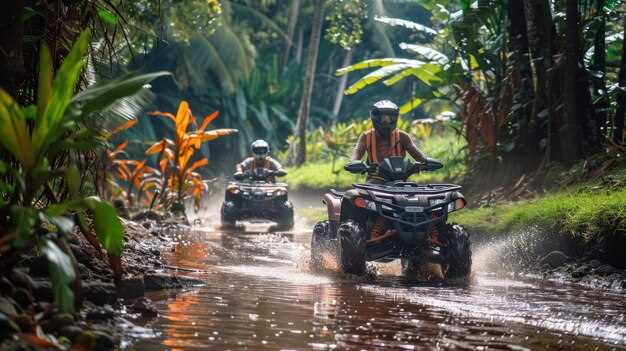Book the 2-hour Bali Quad Biking experience now for a balanced ride that blends picturesque coastal trails with jungle paths. Our base is located in the uluwatu area, and this tour features english-speaking guides who coordinate from check-in to completion. The fees are clearly stated upfront, and the price includes helmet, gloves, insurance, a refreshment break, and on-site facilities. You’ll feel secure along every bend as you ride along coastal cliffs toward a sanctuary viewpoint.
There is a choice of routes across three locations along the coast and into inland forests. Each path delivers a different feel–coastal breeze, river crossings, and shaded jungle corners–so you can pick according to your mood. The routes are designed to be accessible yet engaging for families and groups, with where to turn and stop clearly marked by our guides.
Facilities at the base include clean changing rooms and showers, plus a rest area with bottled water and light snacks. Bring sunscreen, a hat, and a small bag; we provide secure bike storage and a quick safety briefing in english-speaking style to keep everyone comfortable throughout the ride.
Our locations along the coast near uluwatu offer picturesque views that pair with a family-friendly schedule, making it easy to plan a half-day excursion after a morning temple visit or beach time. If you want more adrenaline, you can upgrade to a longer route or add a photo package to capture the moments along the most scenic stretches.
Reserve online now to secure your slot and avoid missing the best conditions. Each booking supports a sustainable approach that respects the sanctuary areas and local communities, keeps the trails well maintained, and ensures consistent service in english-speaking teams.
What to Expect on the Route: Terrain, Pace, and Highlights

Wear sunscreen, bring water, and choose sturdy shoes; each ride starts with a quick safety check and a short briefing, so you can ride with confidence and focus on the track.
Expect a mix of rocky lanes, clay trails, and dirt berms as you move along balis plantation lanes and river valleys. The pace stays moderate, but adventurous riders can push a bit on straight sections, then slow for scenic turns as the guide shows you the best lines. This route is made for control and fun, and it rewards a solid stance and a steady rhythm. When you reach a longer section, then you can decide to push or hold, and that choice will shape how you tackle the trek ahead. The terrain offers much variety across the day.
During the route, weather shifts can change options; rafting happens on the river segment when water levels allow. You might pass through small plantation outposts, and you can explore balis scenery without rushing, while the guide sends tips for safe passing and energy management. A personal briefing and quality gear are included, and you can adjust your pace to your comfort while staying with the group.
To secure your spot, a deposit is required at booking. When you choose a start time, you gain flexibility and opportunities to combine this ride with other Bali activities. If you are new to quads, the instructor covers the basics and keeps the flow practical; if you are experienced, you can push the throttle on open stretches while maintaining control. The route offers a unique mix of adrenaline and culture, and you can share the day with companions or friends who are exploring balis together.
Safety Briefings, Gear, and Rider Readiness
Always wear a certified helmet and sturdy boots before any ride. A 60-second pre-ride check on brakes, tires, throttle, and suspension, plus securing gloves and goggles, prevents surprises on muddy or dirty paths. Review the trip with the guide: route, weather, and habitat notes for the ubud area so you know where blue-marked, muddy, or rough sections might appear along the day. This helps some riders, especially when the ground changes from dusty to slick; tlaga, safety first. Years of field practice show that calm, controlled movements prevent mistakes on tricky sections. This is more than a form; speaking with the guide helps you find the best vantage points and take the right gear for your comfort and safety.
Pre-ride Safety Briefings
Our team runs a concise safety briefing right after check-in. You’ll learn hand signals, right-of-way rules, and what to do if a rider stalls or the trail gets slick. The guided session emphasizes staying on marked paths, keeping a safe distance, and using the buddy system. If wildlife activity is possible along the habitat edges, slow down and back off; we’ve seen a range of animals in remote back sections, but you should never chase or approach them. weve designed the briefing to be practical, with real-time Q&A and tips you can apply on the first turn near Ubud or the blue sections of the route. To reinforce control, the trainer demonstrates a controlled braking drill that mimics a gorilla-like grip on the handlebars for smooth, confident response.
Gear, Personal Readiness, and On-trail Tips

Pack a light rain shell, water, sunscreen, and a compact repair kit. A spare tube or patch kit, tire levers, multi-tool, and pump help you handle flats on muddy or dirty stretches. Your personal gear should include a well-fitting helmet, gloves, knee pads or shin guards, ankle-supporting boots, and moisture-wicking layers to stay comfortable as temperatures shift after sunset during night sightseeing runs near the uluwatu. weve also prepared a simple safety form you can fill out on your phone or email to the team; bring this form to the check-in desk or have it emailed in advance. During the ride, maintain a steady pace, pause at scenic views for photos, and signal the guide if you need a break. If you’re new, opt for a slower option on easier paths while experienced riders can take advantage of blue-grade sections for a bit more challenge. also, for cycling on longer trips, keep a small snack handy and plan a quick back-and-forth to enjoy the views along the route.
Best Time to Ride and Bali Weather Tips
Ride in May–September, during the cool morning hours 7:00–9:30, to enjoy dry trails, clearer sightseeing views, and safer riding conditions. This window makes the most of Bali’s best weather for quad biking and means you’ll experience optimal traction and visibility for the whole route.
Bali is located in Indonesia with a tropical climate that brings two seasons: dry and wet. The dry season delivers lower humidity, less rain, and longer clear windows for riding; the wet season (October–April) brings showers that can turn trails muddy and slick along the countryside. In the tlaga area around Ubud, mornings are often sunny, while showers can arrive suddenly by afternoon. Daytime temperatures usually stay around 26–32°C (79–90°F). Humidity can rise quickly, so stay hydrated and plan short breaks along the route. youll feel the difference when you start early and follow a guided route that avoids impassable sections.
Practical tips for timing, weather and routes
- Best window and times: May–Sept, mornings 7:00–9:30; this means drier trails, cooler air, and clearer views for sightseeing along rice terraces and valleys.
- Weather awareness: in the area around the city and the tlaga corridor, rain can arrive quickly; check a local forecast the night before and adjust the route if needed.
- Gear and safety: equipment is provided by reputable guides, including a helmet and protective gear; wear long sleeves and closed-toe shoes to stay safe on muddy or loose sections. Restrictions apply on some protected trails, so follow the guide’s instructions. theyll tailor the day to weather, trail conditions, and rider level.
- What to pack: sunscreen, a lightweight rain jacket, a refillable water bottle, and a small towel; pack light to stay relaxed and comfortable after the ride.
- Booking and terms: When you book, youll receive a confirmation and terms that outline safety rules and route options; read them to know what opportunities exist and what remains off-limits until you complete the ride.
- City and area vantage: along the route you’ll pass through villages, temples, and rice fields, providing real sightseeing moments that blend adventure with culture.
The whole experience blends safe riding with relaxing scenery and cultural highlights. For wanting a balanced day, the trails along rivers, terraces, and village roads offer opportunities to watch locals at work, grab quick photo stops, and still stay on course. Weve designed the program to be flexible, inviting riders to explore with confidence, and inviting friends to join for a shared memory that stays with you long after you return to your city or resort. The weather might shift, but the core ride remains a real, safe, and enjoyable adventure that you can plan around with confidence.
Logistics: Getting to the Ride, Transfer, and Monkey Forest Timing
Recommendation: Book your pickup at least 24 hours in advance to guarantee a smooth transfer, a real fixed price, and a timely meet at your hotel or villa.
Transfers operate from sites across popular areas, with the driver handling the route to the lush grounds of the ride. The pickup occurs in your lobby or curb, depending on your stay, and the drive to the jungle track runs 60–90 minutes from the Denpasar area, shorter from the southern coast. Expect a brief safety briefing before you mount the quad.
Monkey Forest timing matters for planning after the ride. The forest near Ubud opens around 08:00 and closes by 17:00. For best sightings plan to arrive between 08:00 and 11:00; wear modest clothing and keep a respectful distance from wildlife. The entrance fee hovers around IDR 80,000–100,000 per person, payable at the gate, and the park grounds become busy after 09:30.
We coordinate with a simple logistics flow to keep things smooth; to reference your booking, mention the saren code in advance. This helps align pickup, transfer, and the timing for your group, ensuring the same quality across sites and tours.
What you get is a rich blend of off-road exploration and nature immersion. The route passes through lush springs, tropical habitat, and natural outlines; the drive is basic and safe, with trained guides at the helm. Optional dinner stops at local eateries after the ride let you sample Bali’s flavors without delaying your plans, especially if you want to wind down with family or friends.
What to Bring, Dress Code, and Comfort Tips for ATV Riding
Pack a lightweight rain jacket and sturdy, closed-toe boots; a compact dry bag for your phone, sunscreen, and a reusable water bottle keeps you comfortable through Bali’s dusty tracks, making the ride enjoyable.
Carry cash in small bills for tips, rest stops, or local facilities along the route. Some tours are priced per rider and include gear, but having a little cash lets you enjoy village stops, river viewpoints, paddys fields, and telaga springs without delays. For variety, rafting along the river nearby provides a multi-activity day. Expect white-sand banks and bright river vistas that add to the experience.
Gear and Safety Essentials
The guide team provides a certified helmet, goggles, and gloves; these gear items provide protection and comfort. A light rain cover is available at most facilities, and you should observe the safety briefing before you begin. Solo riders control their ATV with independent throttle, while tandem riders share a seat; ensure the passenger sits securely and balanced on the tracks. If you seek adventurous routes, your guide will propose exciting loops along the river and telaga foothills. theyll explain hand signals and what to do if terrain changes.
Dress Code and Comfort
Wear breathable, quick-dry fabrics and long sleeves to guard against brush and sun. Long pants protect legs on rugged paths, and boots should be sturdy with good grip; tuck laces to avoid snagging on paddys and undergrowth. Apply sunscreen to exposed skin, and sunglasses with a strap help on bright days. Pack a light layer for the evening wind near springs or river crossings; stay hydrated and take occasional breaks to feel refreshed and safe. If you ride solo, your pace is adventurous; if you ride tandem, your passenger may enjoy the switchbacks and playful sections while you maintain control. The route covers several tracks and quiet village paths, and your guide will adjust stops so you can complete the ride with safe confidence.

 Bali Quad Biking – Ultimate ATV Adventures in Bali">
Bali Quad Biking – Ultimate ATV Adventures in Bali">
